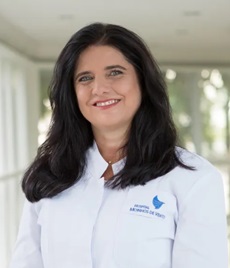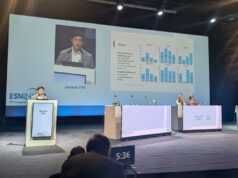This advertorial is sponsored by Medtronic.

Late last year, on 24 November, a decade’s work from a passionate group of physicians bore fruit, with the Brazilian Ministry of Health adding mechanical thrombectomy for stroke to the list of procedures covered by the country’s public health system. Current World Stroke Organization (WSO) president Sheila Martins (Federal University of Rio Grande do Sul, Porto Alegre, Brazil) recently told NeuroNews about the role played by the RESILIENT trial, and Medtronic’s contributions to it, in achieving this historic milestone.
Low- and middle-income countries (LMICs) have very different patient populations compared to their high-income counterparts. As Martins says, in LMICs, emergency rooms are often overcrowded; ambulances and hospital care systems in general are limited; and angio suites tend to be shared with several other specialties, ultimately increasing procedure timelines and leaving acute ischaemic stroke patients more vulnerable. Martins also relays that, in her home country of Brazil, neurointerventionists are trained in private practices but are usually less familiar with working in public hospitals. Hospitals in many other Latin American countries can only deploy monoplane angiography systems in lieu of access to more specialised imaging modalities, and stroke rehabilitation methods are less advanced than in higher-income geographies as well.
“Everything is more difficult and, because of this, it was so important to prove that it is feasible to implement [thrombectomy], with the same results that we have seen internationally, and show that it is cost effective so it is affordable for patients,” Martins says.
While a number of large clinical trials published in 2015 helped to establish thrombectomy as a safe, effective and cost-efficient treatment approach for stroke, Martins states that these studies were conducted predominantly in developed countries across North America and Europe, and thus bore “minimal” relevance to poorer regions. The RESILIENT trial was therefore set up to assess the procedure within real-world practice in a middle-income country like Brazil “for the first time”, according to Martins.
“I think ‘RESILIENT’ is the perfect name for everything we’ve been doing for years here in Brazil, because it is difficult to create a system to treat acute stroke patients,” she comments. “For the trial, we needed to rebuild stroke care in Brazil—organising the prehospital [settings] to evaluate patients for large vessel occlusion [LVO], discussing with health managers to create comprehensive stroke centres, and setting up a network to make it possible to transfer patients from primary to comprehensive centres.”
RESILIENT recap
Conducted at 12 stroke centres across Brazil, the multicentre, prospective RESILIENT randomised controlled trial enrolled nearly 221 patients with LVO acute ischaemic stroke, presenting no more than eight hours from symptom onset, to receive thrombectomy plus medical management, or medical management alone. However, RESILIENT’s data and safety monitoring board recommended the trial should be terminated early, having clearly crossed the prespecified effectiveness boundary at its first interim analysis—at which point 174 patients had available 90-day follow-up data.
Across the 221 patients ultimately enrolled in RESILIENT, thrombectomy displayed superiority to medical management in terms of its primary endpoint of the 90-day ordinal shift in modified Rankin scale (mRS) scores, but also favourable outcomes regarding functional independence (mRS ≤2), and comparable rates of symptomatic intracranial haemorrhage and mortality. Presenting these data back in 2019 at the European Stroke Organisation Conference (ESOC; 22–24 May, Milan, Italy), Martins averred that “the overwhelming efficacy of mechanical thrombectomy persists despite the many limitations encountered in the public healthcare system of a developing country”.
Nearly five years on from the first presentation of these momentous findings—now published in the New England Journal of Medicine—Martins reflects on factors additive to the strength of the intervention itself that enabled RESILIENT to produce such positive outcomes with thrombectomy. Firstly, she hails the significance of training and education, and the contributions of experienced operators like her co-principal investigator Raul Nogueira (University of Pittsburgh Medical Center, Pittsburgh, USA) towards mentoring Brazil’s neurointerventionists. These proctors helped make decisions over whether patients were suitable candidates for stroke thrombectomy, and assisted less experienced operators with more difficult cases, often in real time, in the trial’s early stages.
“One important thing is that we showed it was possible to train the neurointerventionists, specifically for mechanical thrombectomy, in a short space of time,” Martins adds, noting that RESILIENT was able to produce “great results” on par with many other countries. She opines that providing thrombectomy training for all relevant staff—not just neurointerventionists, but also neurologists, nurses, technicians and emergency room staff—was also key.
Vital cost effectiveness
Martins also keenly emphasises the fact that, unlike many high-income countries, Brazil has a healthcare system that covers its entire patient population—and, thus, the criticality of financial analyses at a handful of large, high-volume centres in RESILIENT that showed thrombectomy care was “highly cost effective”. These findings were published in 2021, and revealed estimated incremental costs and quality-adjusted life years gained with thrombectomy plus medical management to be $7,440 (international dollars) and 1.04, respectively, versus medical management alone. Overall, some 1,000 simulations revealed that most of the treatments produced results below a prespecified cost-effectiveness threshold.
Martins cites these cost-utility outcomes as a key reason for stroke treatment via mechanical thrombectomy ultimately gaining approval from the country’s health ministry, and thus being covered within the Brazilian public health sector. She further highlights the fact that initial costs of establishing thrombectomy services are outweighed by decreased rates of hospitalisation, complications, and severe long-term disability. Thrombectomy procedures also enable patients to regain functional independence and return to work more quickly, she adds.
“This is wonderful for the patient, and for society, and it also saves money—all of the financial benefits of the treatment are much higher than the initial cost of the devices, the equipment, and the stroke team,” Martins says. “And RESILIENT was a landmark publication, increasing implementation of the treatment in low- and middle-income countries across the globe, and showing thrombectomy to be very strong even in poorer populations with generally less organised healthcare systems.”
The ideal partner
“Public-private partnership is also very important, because we cannot do anything alone,” Martins continues, alluding to the commitment Medtronic has made towards supporting thrombectomy research in developing countries. “We need partners to have ideas for implementation, to create initiatives for training and educating, and also to negotiate better costs in, for example, LMICs that need a lot more help.”
Prior to the inception of RESILIENT, Medtronic was the first company to sponsor a Brazilian Ministry of Health thrombectomy teaching course launched as part of new national stroke policies in 2012. And, having contributed to RESILIENT itself by supporting training and providing tools like its SolitaireTM revascularisation device for many of the thrombectomies in the trial, Medtronic has since sponsored WSO-led education across Latin America to help train more interventionists in the procedure.
“That is so important, because the procedure is wonderful, but it really requires training and skills, and the organisation of services—and Medtronic has supported these efforts,” Martins notes. “Medtronic has also supported the certification of stroke centres, firstly in Latin America and now in India, which is fundamental to ensuring all evidence-based strategies are implemented in clinical practice. All of this makes Medtronic a very important partner of the WSO, and [for] increasing the assessment of the best stroke treatments for patients across the globe.”
Finally, she commends Medtronic’s contributions to the WSO’s Global Stroke Alliance (GSA) meetings over the past few years. These meetings are intended to pull together specialist physicians, researchers, healthcare managers, stroke support organisations, public and private hospitals, and industry, to discuss the best strategies for policy implementation. “Here, it is not about the results of clinical trials,” Martins says. “It is about how to implement what we already know, and what we have shown to be [clinically] effective and cost effective.”
Medtronic is the leading sponsor of these efforts, having supported the earliest GSA meeting iterations in 2020 and 2022—both held in Brazil—and the 2023 edition in New Delhi, India, which brought together nine countries from across Asia. According to Martins, Medtronic has played a major part in these endeavours and many others, including a conference hosted in Uruguay that drew hundreds of attendees from 13 Latin American countries in November last year.
“Medtronic is proud of its partnership with the WSO and the GSA,” said Signe Haughton, senior director, Neurovascular Medical and Government Affairs, Medtronic. “We are focused on driving education and training, and supporting policy initiatives that will ensure the best stroke treatments are accessible to all patients around the world. Medtronic Neurovascular’s strategy—centred on doubling the number of people we help treat to 500,000—requires us to not only optimise care for those who have access but, as importantly, increase access for those who don’t.”
DISCLAIMER: SolitaireTM is a trademark of Medtronic, Inc.










